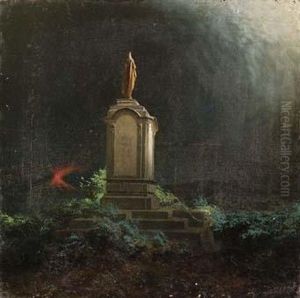Karl W. Diefenbach Paintings
Karl Wilhelm Diefenbach was a German painter and social reformer, born on February 21, 1851, in Hadamar, Nassau. Diefenbach is often remembered as a pioneer of the life reform movement and a progenitor of alternative culture, advocating for a return to nature, vegetarianism, and abstinence from alcohol and tobacco.
Diefenbach studied at the Munich Academy of Fine Arts and was influenced by the Symbolist movement and the works of Arnold Böcklin. His early works were characterized by mythological themes and allegorical subjects, often with a focus on the harmony between man and nature. His artistic style combined elements of symbolism and realism, with a significant emphasis on naturalistic and sometimes mystical themes.
Around 1887, Diefenbach founded a commune named Himmelhof in the outskirts of Vienna. The commune aimed to embody the principles of communal living, naturalism, and artistic freedom. However, conflicts with the local community and financial difficulties eventually led to the dissolution of Himmelhof, and Diefenbach moved back to Germany.
Despite facing public ridicule and financial hardship throughout his life, Diefenbach remained committed to his ideals. He produced a diverse body of work including paintings, drawings, and prints that reflected his philosophical beliefs. His commitment to pacifism, environmentalism, and utopianism was also evident through his lifestyle and his teachings.
Karl W. Diefenbach died on December 15, 1913, in Capri, Italy, where he had spent the latter part of his life. Although not widely known today, Diefenbach's work and life philosophy had a lasting impact on future generations of artists and reformers, influencing the hippie movement and other countercultural movements in the 20th century. His legacy is preserved through his art, which can be found in various European museums, and through the continued interest in alternative lifestyles and holistic approaches to living.
